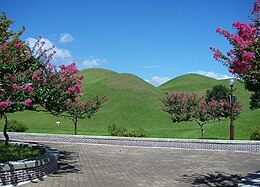Gyeongju Historic Areas
This article includes a improve this article by introducing more precise citations. (April 2009) ) |
| UNESCO World Heritage Site | |
|---|---|
 Royal tumuli at Gyeongju | |
| Location | Gyeongju, North Gyeongsang Province, South Korea |
| Criteria | Cultural: (ii), (iii) |
| Reference | 976 |
| Inscription | 2000 (24th Session) |
| Area | 2,880 ha (7,100 acres) |
| Buffer zone | 350 ha (860 acres) |
| Coordinates | 35°47′20″N 129°13′36″E / 35.78889°N 129.22667°E |
| Korean name | |
| Hangul | 경주 역사유적 지구 |
|---|---|
| Hanja | |
| Revised Romanization | Gyeongju Yeoksayujeok jigu |
| McCune–Reischauer | Kyǒngju Yǒksayujǒk chigu |
The Gyeongju Historic Areas of
Organization of the areas
Mount Namsan Belt

The
The Wolseong Belt
The main attractions of this portion of the Gyeongju Historic Areas are the ruins of
The Tumuli Park Belt
This belt consists of three groups of royal tombs. Most of the tumuli are shaped like domes or mounds of earth. However, some are shaped like gourds or half-moons. Excavated tombs reveal wooden coffins covered with gravel and rich grave goods of gold, glass, and quality ceramics. A famous example of a tomb in this park is the
The Hwangnyongsa Belt
This cluster of historic remains is centered around the ruins of Hwangnyongsa Temple and Bunhwangsa Temple. According to the excavated foundation stones, Hwangnyongsa was the largest temple ever built in Korea and covered 72,500 m2. The Bunhwagsa Temple exists today at a fraction of its size. In the past, it was one of the most important Buddhist temples. A stone pagoda made from brick-like stones is a popular ruin. It is believed to have had seven or nine stories but only three remain today.
The Sanseong Belt
This portion of the property includes the ruins of the Myeonghwal mountain fortress (Myeonghwal Sanseong) situated on Mount Myeonghwal at Bomun Lake about 6 kilometres east of the downtown of Gyeongju.

